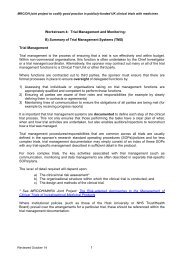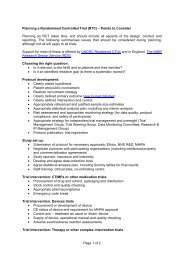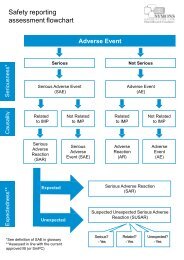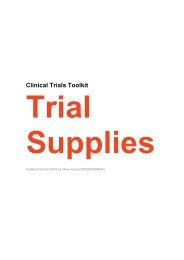Monitoring Procedures Workstream Document (PDF, 379.02 KB)
Monitoring Procedures Workstream Document (PDF, 379.02 KB)
Monitoring Procedures Workstream Document (PDF, 379.02 KB)
You also want an ePaper? Increase the reach of your titles
YUMPU automatically turns print PDFs into web optimized ePapers that Google loves.
MRC/DH joint project to codify good practice in publicly-funded UK clinical trials with medicines<br />
Where centralised monitoring indicates problems, it can be used to efficiently direct on-site<br />
monitoring activities to those sites requiring further investigation and/or additional training<br />
support.<br />
Although omissions (e.g. failure to report a serious adverse event) or data entry errors cannot<br />
be detected directly, it may be possible to compare data from different sites to identify sites that<br />
warrant investigation.<br />
Basic central statistical monitoring checks include 5 :<br />
1. Missing or invalid data; Range checks can be used to identify unlikely or implausible<br />
values, such as extreme values for weight, or diastolic greater than systolic blood<br />
pressure. For trials using electronic data capture methods, these checks can usefully<br />
be built into the data collection form; any such automatic safeguards should be validated<br />
to ensure that they function correctly.<br />
2. Calendar checks; Examining the day of the week that subjects were randomised can<br />
be revealing (e.g. randomisation on Sunday in a trial of patients attending<br />
outpatient clinic). It is also helpful to compare the order of trial forms (particularly if<br />
they have an ordered numbering system) with the dates they were completed.<br />
3. Unusual data patterns; Data from one site can be compared with data for the trial as a<br />
whole to identify patterns such as digit preference, rounding, or unusual frequency<br />
distribution (e.g. mean, variance, skewness). Such checks can be applied both to a<br />
single variable (e.g. systolic blood pressure) and to the joint distribution of several<br />
variables (e.g. systolic blood pressure and weight).<br />
4. Rates of reporting; The frequency of reported adverse events and of missing data can<br />
be compared between sites.<br />
5. Repeated measures; Where the same variable is measured on multiple occasions for<br />
each subject during the trial, it is possible to check that the variability and withinindividual<br />
changes of such repeated measurements is broadly consistent with<br />
the pattern seen for the trial as a whole.<br />
6. Comparison with external sources; Checks with birth and death registries or with diseasespecific<br />
registries (e.g. cancer registry) can be used to identify that particular patients<br />
exist and that particular events have (or have not) occurred.<br />
When applying these checks it is important to recognise that some variability is to be expected.<br />
Data that are too good should raise suspicion in the same way as data that are unusually poor.<br />
Various complementary central statistical monitoring techniques can be adopted that focus on<br />
comparing sites using the concepts listed above. A key risk indicator approach based on<br />
examining the main aspects of trial performance that are likely to impact subject safety and trial<br />
reliability can be useful for identifying problem sites 6 . For example, compliance with trial treatment<br />
is generally a useful key risk indicator. An excess of non-compliance at a particular site has the<br />
potential to impact trial reliability and may indicate poor on-site performance. In addition, central<br />
statistical monitoring techniques based on examining all aspects of the trial data, rather than<br />
selected indicators, are potentially useful for identifying sites that may require further<br />
investigation 7 .<br />
Other Remote <strong>Monitoring</strong> Checks: It is common practice for the sponsors of small, noncommercial<br />
trials to utilise self-assessment checklists/progress updates to help confirm<br />
5 M Buyse, SL George, S Evans, et al. for the International Society for Clinical Biostatistics Subcommittee on<br />
Fraud. The role of biostatistics in the prevention, detection and treatment of fraud in clinical trials. Statist<br />
Med 1999;18:3435-51.<br />
6<br />
E Valdés-Márquez, JC Hopewell, M Landray, J Armitage. A key risk indicator approach to central<br />
statistical monitoring in multicentre clinical trials: method development in the context of an ongoing largescale<br />
randomized trial. Trials 2011, 12(Suppl 1):A135.<br />
7 D Venet, E Doffagne, T Burzykowski, F Beckers, Y Tellier, E Genevois-Marlin, U Becker, V Bee, V<br />
Wilson, C Legrand, M Buyse. A statistical approach to central monitoring of data quality in clinical<br />
trials. Clin Trials (published online ahead of print, 8 th June 2012).<br />
Updated November 2012 4







